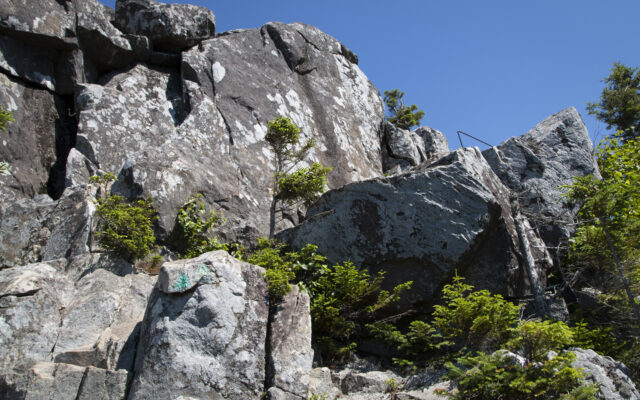
7 Maine hiking trails where dogs aren’t allowed
By Lindsay Putnam, Bangor Daily News Staff
There’s no shortage of hiking trails in Maine that you can conquer with your four-legged friend.
Many of the state’s most popular parks, including Acadia National Park, welcome dogs as long as they’re leashed.
Typically, the only limiting factor for hiking with your dog will just be what kind of terrain and distance your dog can handle.
But some hikers may want to seek out hikes where they won’t encounter dogs. Whether it’s personal preference or the desire to enjoy nature with minimal noise and interruptions, here’s where you can hike and not worry about dogs crossing your path.
Barred Island Preserve on Deer Isle
Located on the west side of Deer Isle, Barred Island Preserve features about 1.5 miles of nature trails that wind through a whimsical boreal fog forest to a sandy beach on the coast. And if you time your visit right, you can then cross over a sandbar to explore the scenic, undeveloped Barred Island. There is no trail on Barred Island, but you can walk around the island on the large granite slabs that surround it. Take care navigating the rocks, which become slippery closer to the water.
Borestone Mountain, in Maine’s 100-Mile Wilderness
Rising nearly 2,000 feet above sea level, Borestone Mountain is a popular hike in Maine’s 100-Mile Wilderness region. From the mountain’s two bald peaks, hikers are rewarded with breathtaking 360-degree views of the area. This 4.2-mile hike, out and back, includes more than 200 stone steps and a few metal rungs to help you up the steepest sections.

BORESTONE MOUNTAIN – Steel rungs are located near the West Peak of Borestone Mountain to help hikers up especially steep sections of trail.
Fields Pond Audubon Center in Orrington
Straddling the border of Orrington and Holden, Fields Pond Audubon Center is a 229-acre wildlife sanctuary that’s home to a network of nature trails, as well as a nature center where public programs are regularly held. It’s one of eight sanctuaries owned and managed by Maine Audubon, the state’s oldest wildlife conservation organization. At least 130 bird species have been spotted on the property.
Orono Bog Boardwalk in Orono and Bangor
The 1-mile boardwalk loop trail begins at the forested wetland edge in the Bangor City Forest, which is lined with bog maples, cinnamon ferns and skunk cabbage. After 800 feet, the path crosses the town line into the University of Maine-owned section of the bog in Orono. The path leads to the open center of the bog, an area covered in peat moss, stunted vegetation, and fascinating plants such as the carnivorous pitcher plant. Benches are located at least every 200 feet. This boardwalk, along with the 0.25-mile woodland trail leading to it, is handicap accessible and great for walking strollers. Only service dogs are allowed.
Fernald’s Neck Preserve in Lincolnville
The 328-acre Fernald’s Neck Preserve occupies much of a peninsula that juts out into Megunticook Lake, a beautiful body of water in Lincolnville and Camden. Established in 1969, the preserve is home to an old evergreen forest, nearly 4 miles of shoreline, The Great Bog and about 3.5 miles of walking trails. The preserve’s key feature is a large boulder referred to as “Balance Rock” that’s just a short walk from the trailhead on the Blue Trail and Yellow Trail. The Orange Trail and the far end of the Blue Loop are rocky and hilly, making them the most challenging areas of the trail network.
Indian Point-Blagden Preserve in Bar Harbor
Located on the western side of Bar Harbor on Indian Point Peninsula, the Indian Point-Blagden Preserve is home to about 2.7 miles of woodland hiking trails and a 1-mile gravel road that also makes for a nice place to walk. Trails on the property lead through a mossy evergreen forest to the ocean where you’ll find interesting rock formations and an expansive gravel beach. The Fern Trail leads to an area of the shore that’s dominated by outcroppings of Ellsworth schist, the oldest rock found on Mount Desert Island. The Shore Trail leads to a large gravel beach and another area of outcroppings, with offshore ledges that are frequented by sunning harbor seals.
Debsconeag Ice Caves near Millinocket
The trail to the ice caves is just more than 1 mile and weaves through tall pines and large glacial erratics covered in moss and ferns. The caves are talus, meaning a pile of heavy boulders that were plowed together by glaciers during the last ice age. There are metal rungs, courtesy of the Nature Conservancy, to climb down into the cave. As you descend, the temperature drops – a sensation much like stepping into a freezer. During the spring and summer, the ice coating the walls of the caves starts to melt and form icicles. From the large main room, hikers can clamber over boulders and shimmy into smaller rooms — though this type of exploration is not for people afraid of confined spaces. People aiming to spend time in the caves would be more comfortable bringing mittens and pants.